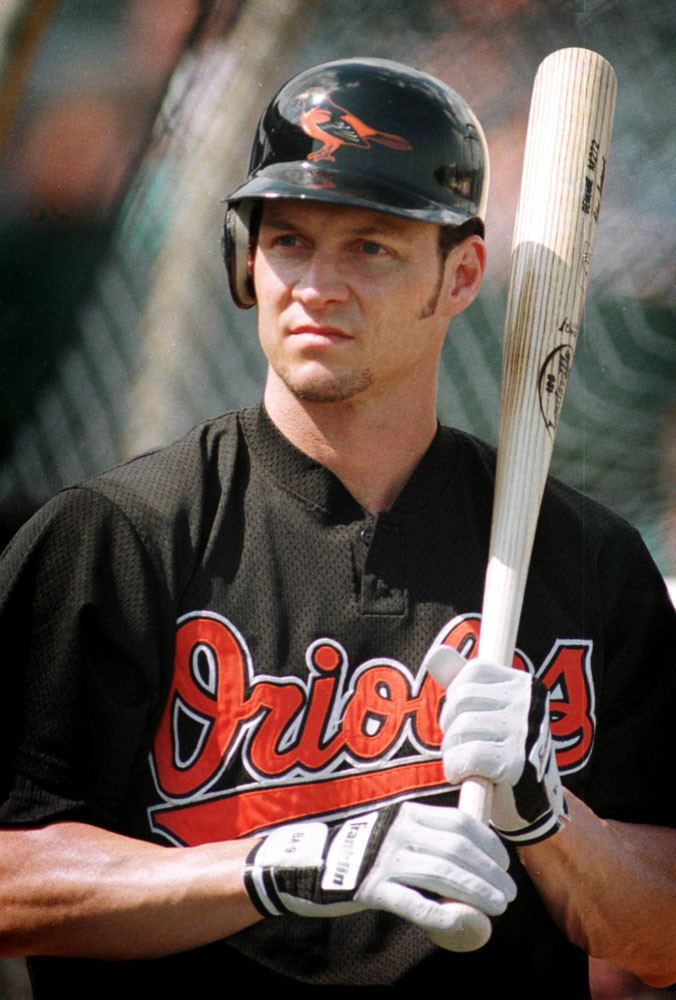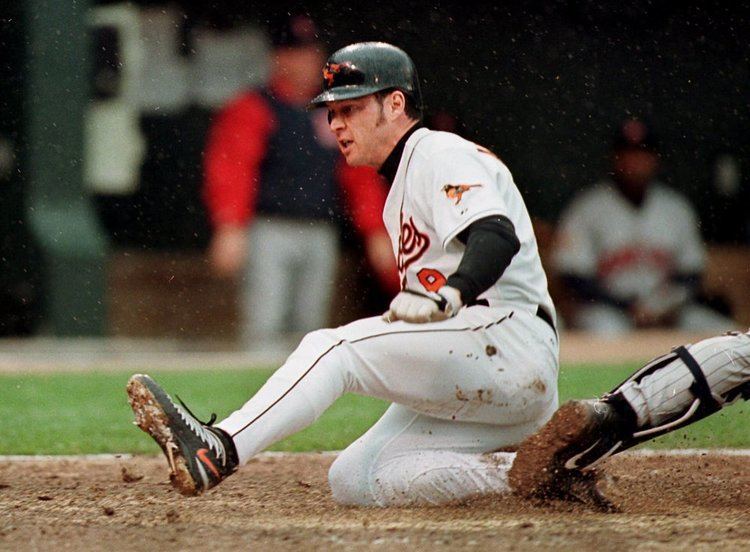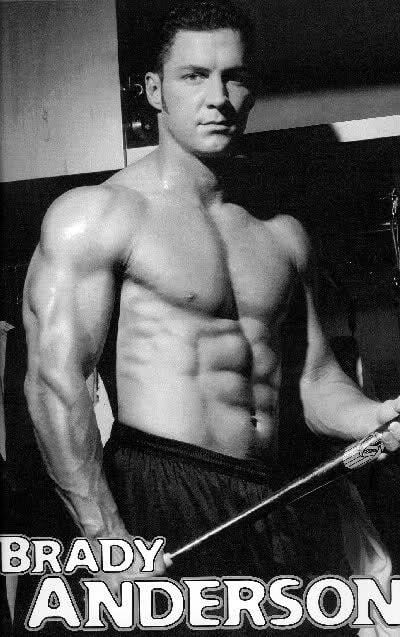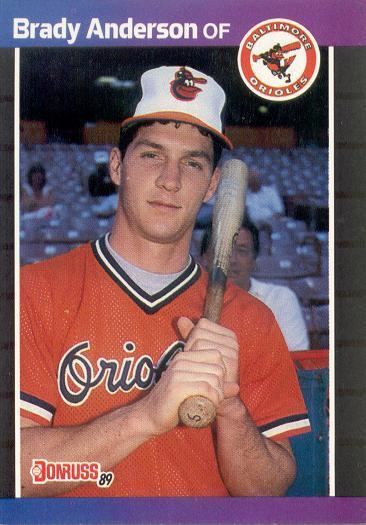Batting average .256 Role Baseball player Ex-spouse Sonia Vassi Name Brady Anderson Children Brianna Anderson | Runs batted in 761 Weight 92 kg Home runs 210 Height 1.85 m | |
 | ||
Similar People Rafael Palmeiro, Albert Belle, B J Surhoff, Chris Hoiles, Mike Mussina | ||
Brady anderson fox pre game interview with steve lyons
Brady Kevin Anderson (born January 18, 1964) currently serves as Vice President of Baseball Operations for the Baltimore Orioles. He is a former outfielder with the Orioles, Boston Red Sox and Cleveland Indians of Major League Baseball.
Contents
- Brady anderson fox pre game interview with steve lyons
- Brady anderson hits 50 home runs leadoff hitter baltimore orioles
- Early life
- 19881991
- 1992
- 1993
- 1994
- 1995
- 1996
- 1997
- 1998
- 1999
- Postseason
- Legacy
- After baseball
- Work in Japan
- References

Anderson spent the majority of his career as an Oriole, primarily as a center fielder throughout the 1990s, when he was a three-time All Star. In 1996, Anderson hit a team-record 50 home runs (later surpassed by Chris Davis in 2013). Anderson was inducted into the Baltimore Orioles Hall of Fame in 2004.

Brady anderson hits 50 home runs leadoff hitter baltimore orioles
Early life

Anderson was born in Silver Spring, Maryland on January 18, 1964 and attended Carlsbad High School in Carlsbad, California. He went on to study economics at the University of California, Irvine where he played outfield and first base for the Anteaters. He left college following his junior season after being drafted in the 10th round of the 1985 Major League Baseball draft by the Boston Red Sox.
1988–1991

Anderson made his major league debut on April 4, 1988. On July 30, he and Curt Schilling were traded to the Baltimore Orioles for Mike Boddicker. Anderson hit his first major league home run on August 6 off of Milwaukee's Tom Filer at Baltimore's Memorial Stadium.
1992
In only his first season as a full-time player in 1992, Anderson played in all but three of the Orioles games and led the major leagues with 749 plate appearances. He earned his first of three All-Star nominations and played in the 1992 All-Star Game at San Diego on July 14. By season's end, he had become the first player in American League history to reach 20 homers, 50 steals and 75 RBI in a season. Anderson finished 15th in AL MVP voting.
1993

Despite missing 15 games with chicken pox and patellar tendinitis in both knees, Anderson led all American League leadoff hitters in extra-base hits (56) and RBI (62). He also led the Orioles in eight offensive categories, including runs scored (87), stolen bases (24), walks (82), triples (8), and extra base hits (57). He batted .571 (8-14) with the bases loaded, the fourth highest total in the American League.
1994
The 1994 season was cut short two months by the player's strike. Anderson led all American League left fielders with a 1.000 fielding percentage, and his 31 stolen bases in 32 attempts was a major league record for 25 or more steals.
1995
On June 12, Anderson set an American League record with 34 consecutive stolen bases. The streak ended on July 3 at 36 when he was caught by Minnesota Twins catcher Matt Walbeck. His record was eclipsed by Chicago's Tim Raines later in the year and was matched by Toronto's Paul Molitor. Anderson was the hardest to double up in the American League, grounding into only three double plays on the year: once every 184.7 at-bats. He hit two home runs on September 5, the night teammate Cal Ripken, Jr. tied Lou Gehrig's consecutive games played record of 2,130. On September 6, Anderson spoke on behalf of his teammates at a post-game ceremony honoring Ripken's 2,131st consecutive game.
1996
Anderson went into the final game of the 1996 season (visiting the Toronto Blue Jays) with 49 home runs. In his first at-bat, he hit his 50th homer off Cy Young Award winner Pat Hentgen, breaking Frank Robinson's record for most home runs in a season by a Baltimore Oriole. He also became the only player in major league history to be in the 50–20 club and the 20–50 clubs. Anderson also shattered a major league record by leading off four consecutive games with a home run. The previous mark was two straight games, done 33 times. In the annual Baseball America "Tools of the Trade" poll, Anderson was named as the league's third-best defensive outfielder, behind only Seattle's Ken Griffey Jr. and Cleveland's Kenny Lofton. Anderson also hit 37 doubles and five triples and led the American League in extra base hits with 92, breaking the Orioles club record previously held by Cal Ripken Jr.
Anderson had more than doubled his previous best of 21 home runs in 1992, and his uncharacteristic power surge has since led to allegations that he used performance-enhancing drugs during the 1996 season.
1997
Despite playing most of the 1997 season with a broken rib, Anderson led the Orioles to a wire-to-wire American League East title with a record of 98-64. Anderson made his third All-Star appearance at the 1997 All-Star Game in Cleveland, where he played the entire game in the leadoff spot for the American League and went 2 for 4 with a double high off the 19-foot left field wall against pitcher Curt Schilling.
Anderson led the Orioles in 13 offensive categories: batting average (.288), on-base percentage (.393), OPS (.862), plate appearances (696), runs scored (97), hits (170), doubles (39), triples (7), walks (84), stolen bases (18), and extra base hits (tied with Rafael Palmeiro – 64). He was hit by pitches a league-leading 19 times, marking the second straight year he led the league.
1998
Anderson appeared on the cover of the Konami video game Bottom of the 9th '99. The game was released on August 31, 1998 for the PlayStation.
1999
In 1999, Anderson rebounded from an injury-plagued 1998 campaign for one of the best all-around seasons of his career. He led American League leadoff hitters with a .408 on-base percentage and reached base 279 times, ninth most in the league. For the season, Anderson batted .282 with 28 doubles, 5 triples, 24 home runs, 109 runs scored, 81 runs batted in, 36 stolen bases, 96 walks, and 24 hit by pitch. He became the only leadoff hitter in history with three 75 RBI seasons to his credit. On May 23, Anderson became the first player in American League history to be hit by a pitch twice in the same inning. He broke his own American League record for hit by pitch in a season by a left-handed batter, set in 1996. The previous record was held by Washington's Harry Gessler, who was hit 20 times in 1911. In a post-season statistical analysis by Baseball America, Anderson was rated as the best leadoff hitter in the American League.
Postseason
In four post-season series, (Cleveland Indians and New York Yankees in 1996, Cleveland Indians and Seattle Mariners in 1997) Anderson had 80 at bats, 16 runs scored, 4 doubles, 6 home runs, a .300 batting average, a .380 on-base percentage, and a .575 slugging percentage.
In the 1997 playoffs, Anderson hit .353 against Seattle with a .588 slugging average and a .360 batting average against Cleveland with a .680 slugging average.
Legacy
Anderson still ranks among the top ten in Orioles career batting leaders for games (1759), at-bats (6,271), runs (1,044), total bases (2,698), hits (1,614), doubles (329), triples (64), home runs (209), RBI (744), extra base hits (602), stolen bases (307), and walks (927). He holds the single-season records for total bases (369 in 1996) and hit by pitch (24 in 1999).
As of 2016, Anderson is one of only two players (the other being Barry Bonds) to have stolen 50 or more bases in a season (53 in 1992) and hit 50 or more home runs in a season (50 in 1996). (Bonds stole 52 bases in 1990 and hit 73 home runs in 2001.)
Anderson was not able to duplicate his 50 home run season; however, for a nine-year stretch from 1992–2000, he averaged 21 home runs, 6 triples, 31 doubles, 96 runs scored, 70 RBI, 27 stolen bases, a .376 on base average, a .462 slugging average, and 14 hit by pitch per year as a leadoff hitter, despite one season shortened two months by a player strike (1994) and another shortened one month by owner lockout (1995).
After baseball
On August 21, 2004, Anderson was inducted into the Baltimore Orioles Hall of Fame. Cal Ripken, Jr. introduced Anderson and called him "the greatest leadoff hitter in Orioles baseball, and the best athlete I have ever played with." During Ripken's induction ceremony to the Baseball Hall of Fame in 2007, he described Anderson as "simply my best friend."
In 2012, Anderson was named special assistant to the executive vice president of baseball operations by the Baltimore Orioles.
In 2013, Anderson was promoted by the Baltimore Orioles to the role of Vice President of baseball operations.
Work in Japan
Brady Anderson joined Ripken on a journey to Japan, the first trip for Anderson as a "sports diplomat". Anderson was an obvious choice for a companion for Ripken because it is said that Anderson is someone who "could help on the mission, spread goodwill and be with kids". Anderson and Ripken were joined by Japanese baseball's Sachio Kinugasa.
The trip took place November 8–16, 2011, and included visits to several towns (Tokyo, Ofunato, Nishinomiya, and Kyoto) affected by the March 2011 earthquake and tsunami. During the trip to Japan, Anderson and Ripken hosted baseball and softball clinics, as well as motivational activities.
